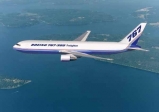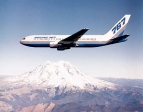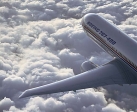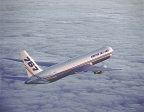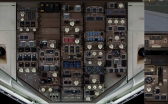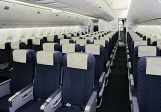
Production of the venerable 707 airframe ended in May 1991. Following studies of the most suitable follow-on aircraft for the AWACS mission, Boeing announced in December 1991 that it would offer a modified 767 commercial jetliner as the platform for the system. By 2003 the 767 had a new multi-decade role as an aerial tanker.
The 767-200 provides several advantages over the 707. Because of its wide-body configuration, the 767 offers 50 percent more floor space and nearly twice the volume of the 707. The 767 can carry a heavier payload, has a greater range and flies higher than the 707. The two-person flight crew and high-reliability twin engines also provide economic advantages. More than 590 commercial 767 aircraft are in service with 54 of the world's airlines, and there is a wide base of suppliers, spare parts and support equipment. The 767 is produced at a rate of about four each month.
Equipped for extended-range twin-engine operations (ETOPS), the 767 has enabled commercial airlines to realize economic benefits and retire less-efficient three- and four-engine airplanes from long-range routes. The 767 has become the dominant aircraft on North Atlantic routes, making more flights daily between Europe and North America than any other commercial aircraft model. Of all commercial transatlantic flights, more than one-third are flown with the 767. The 767 has safely flown over 600,000 extended-range flights and adds 10,000 more each month.
Normally, the FAA first certifies a twin-engine plane for flights of not more than one hour from an airport, then two hours, and finally, after a couple year's service, a full three hours so the plane could fly anywhere in the world. The 767, powered by Pratt & Whitney JT9D-7R4D/E turbofan engines, became the first Boeing twin to win 120-minute approval in May, 1985, but not until after it had flown for two years.
Boeing's conservative approach was illustrated in the 1970s and 1980s when it decided not to include in its 767 more advanced systems such as fly-by-wire, fly-by-light, flat panel video displays, and advanced propulsion systems (Holtby, 1986). Even though the technology existed, Boeing did not believe it was mature enough for the 767. Boeing also used what Gansler defines as a design-to-cost constraint. After Boeing defines a program it evaluates cost before going into production. Its cost evaluations include trade offs of performance, technology, and manufacturing investments.
With a first flight date in September 1981, the Boeing 767-200 entered airline service in the late summer of 1982.
The Boeing 767-200 is a 290-passenger, double-aisle, wide-body airliner designed to replace the aging Boeing 707 and McDonnell Douglas DC-8 transports now used on domestic and foreign medium range route segments. Average stage lengths over which the aircraft will be operated are estimated by Boeing to lie between 850 and 1150 miles. Maximum range is, of course, much greater and includes a nonstop United States coast-to-coast capability; the twin-engine 767-200 is not intended for long over-ocean flights.
The configuration of the Boeing 767-200 is conventional with the wing located in the low position at the bottom of the fuselage and with one of the two engines pylon mounted beneath each wing. Location of the engines under the wing, rather than to the rear of the fuselage, allows the horizontal tall to be mounted in the low position. A low tall position is helpful in minimizing pitching-moment nonlinearities that are often characteristic of sweptback wings at angles of attack in the vicinity of the stall. The main landing gear consists of two struts, each with a four-wheel bogie, that retract inward into the wing root.
Although of conventional configuration, the detailed aerodynamic design of the 767-200 is highly refined, as might be expected by the nearly 25 000 hours of wind-tunnel time required in the development of the aircraft. To place this wind-tunnel effort in perspective, 14 000 and 4000 wind-tunnel hours were expended in developing the Boeing 747 and 727, respectively.
The Boeing 767-200 has been widely advertised as being much more fuel efficient than earlier generations of jet transports. Although the careful aerodynamic design just mentioned contributes to the efficiency of the aircraft, the high-bypass-ratio turbofan engines employed on the 767-200 are primarily responsible for its high fuel efficiency. At present, the 767-200 is offered with two versions of both the Pratt & Whitney JT9D and the General Electric CF6 turbofan engines. Both of these engines are in the 48 000- to 50 000-pound thrust range and have bypass ratios between 4.5 and 5.0 and compressor pressure ratios between 25 and 30. Specific fuel consumption of these engines, expressed in pounds of fuel per pound of thrust per hour, is between 20 and 25 percent lower than that of the Pratt & Whitney JT3D engine that powers both the McDonnell Douglas DC-8 and the Boeing 707.
Plane info
Cruise speed: 870 km/h
Total range: 9 400 km
Engines: 2 x General Electric CF6-80A
Aircraft dimensions
Wingspan: 47.57 m
Length: 48.51 m
Cabin
Passengers: up to 255

